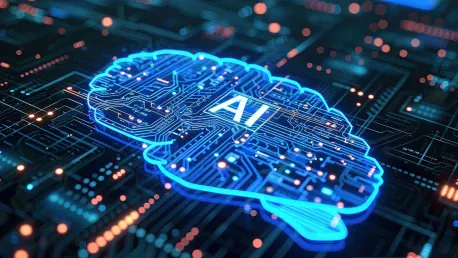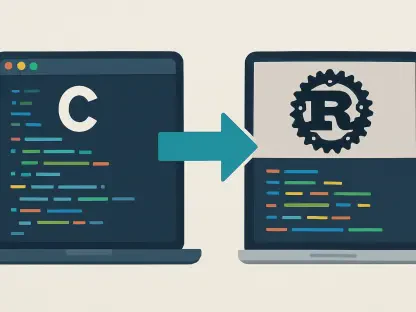Deep learning, a sophisticated subset of artificial intelligence (AI), has transformed the landscape of technology with its advanced neural networks. By mimicking the human brain’s processing capabilities, deep learning models can make highly accurate predictions and inform decision-making across various applications. This article delves into the intricacies of deep learning, its frameworks, architectures, and the diverse use cases that showcase its revolutionary impact on AI.
The Fundamentals of Deep Learning
Deep learning operates through a layered hierarchy of machine learning algorithms, each layer handling progressively more complex and abstract data. The structure of deep neural networks (DNNs) is pivotal to this process, comprising three main types of layers: input, hidden, and output. The unique function and synergy between these layers form the backbone of deep learning models, providing the structural foundation that enables these models to engage and interpret large and complex datasets effectively.
The input layer captures raw data, such as pixels in an image or words in a sentence, and passes it onto subsequent stages. This is where data begins its transformation journey, laying the groundwork for more nuanced analyses. Hidden layers, which are intermediate computing stages, then process this input data. The number and interconnections of these hidden layers contribute to the model’s depth and complexity, allowing for a hierarchy of features to be identified and learned. Finally, the output layer produces the model’s end result, which could be a prediction, classification, or decision, depending on the task at hand. This hierarchical learning process is essential for achieving the high levels of accuracy and efficiency that characterize deep learning applications.
Training Deep Learning Models
The training process of deep learning models is iterative and requires large datasets and substantial computational power. The model learns by adjusting its parameters—weights and biases—to minimize error through repeated analysis until the desired accuracy or performance metrics are achieved. This continuous fine-tuning is critical to developing a model capable of making highly accurate predictions and performing complex tasks with minimal supervision.
Key components of deep learning algorithms include the loss function, which measures how well the model’s predictions match true values, and forward propagation, which involves passing input data through the layers to determine the output. The learning rate, which adjusts how much weights and biases are updated, also plays a crucial role in influencing the model’s accuracy. If the learning rate is too high, the model might overshoot the optimal parameters; if too low, the training process can become unnecessarily lengthy or stagnate without reaching optimal accuracy. Additionally, backpropagation—a method used to calculate the gradient of the loss function—is pivotal for optimizing the model by adjusting the weights and biases in the opposite direction of the gradient to minimize the error.
Deep Learning Architectures
The architecture of a deep learning model dictates how layers are connected and how data flows through them. Different types of deep learning models, defined by their specific architectures, are suited for various tasks. The design principles underlying these architectures determine their effectiveness and efficiency in handling particular types of data and tasks, thereby influencing their application across different fields.
Convolutional Neural Networks (CNNs) are particularly effective for image recognition and processing due to their ability to consider spatial hierarchies in data. They automate feature extraction through layers of convolutions, making them suitable for tasks ranging from facial recognition to complex scene analysis. Recurrent Neural Networks (RNNs), on the other hand, are designed for sequential data processing, such as time series or natural language, taking into account temporal dependencies. RNNs are particularly beneficial for language modeling and predictive text applications. Long Short-Term Memory Networks (LSTM), a subtype of RNNs, address the limitations of standard RNNs by incorporating mechanisms to learn long-term dependencies, crucial for tasks like speech recognition and machine translation.
Generative Adversarial Networks (GANs) are another noteworthy architecture, used for generating new data that closely resembles the training dataset. GANs consist of two networks—the generator and the discriminator—that compete against each other, resulting in highly realistic data generation. Deep Belief Networks (DBN) comprise multiple layers of stochastic, latent variables, and can discover intricate structures in the data, making them effective in unsupervised learning scenarios.
Applications in Computer Vision
Deep learning has made significant strides in the field of computer vision, enabling technologies that were once thought to be science fiction. Object detection, for instance, is critical for self-driving cars to recognize pedestrians and road signs, ensuring safety and navigation accuracy. Deep learning’s ability to pinpoint and classify multiple objects within a single image has revolutionized how machines interpret visual data, making autonomous systems more reliable and efficient.
Image classification allows systems like Google Photos to categorize objects, scenes, or activities with remarkable accuracy. This capability involves assigning labels to images based on their content, layering these interpretations to discern finer details and contexts. Facial recognition technology, used in tools like Microsoft Hello for password-free sign-ins, identifies individuals using unique facial features with a high degree of precision. This application has implications for security, personal identification, and access management, leveraging the nuanced pattern recognition capabilities of deep learning algorithms.
Image generation, as seen in OpenAI’s DALL-E, creates new images from text or other visuals, showcasing the creative potential of deep learning. By understanding and mimicking intricate patterns found in visual data, these systems can generate highly realistic images based on textual descriptions, opening new avenues in creative industries and content creation. This innovative approach demonstrates the vast possibilities unlocked by deep learning in computer vision, where machines can now create, interpret, and understand visual content as never before.
Advancements in Natural Language Processing (NLP)
Natural Language Processing (NLP) is another area where deep learning has revolutionized AI. Machine translation, exemplified by Google Translate, converts text from one language to another with remarkable accuracy. This capability is rooted in deep learning’s ability to understand and model the context of language, capturing nuances that traditional models often miss. By leveraging large datasets and advanced architectures, deep learning models can translate text while preserving meaning and tone, making cross-language communication more effective.
Sentiment analysis determines the emotional tone in text, aiding brand monitoring systems like Brandwatch. By analyzing patterns in textual data, deep learning models can classify sentiments as positive, negative, or neutral, providing valuable insights for businesses to gauge public perception and sentiment trends. This application extends to customer feedback analysis, social media monitoring, and market research, where understanding public sentiment can drive strategic decisions.
Question answering systems, such as Siri and Alexa, respond to user queries with increasing sophistication. These systems leverage deep learning models trained on vast datasets to understand natural language queries and provide relevant, context-aware responses. Text generation, as demonstrated by OpenAI’s GPT models, creates coherent and contextually relevant text, pushing the boundaries of what AI can achieve in language understanding and generation. These models generate human-like text, enabling applications in content creation, customer service automation, and more, showcasing the transformative impact of deep learning on NLP.
Innovations in Speech Processing
Speech processing has also benefited immensely from deep learning. Speech-to-text technology, used in transcription services like Google’s speech-to-text, converts spoken language into text with high accuracy. This capability relies on deep learning models’ ability to recognize and interpret diverse accents, dialects, and speech patterns, making transcription more accessible and efficient. The precision of these models continues to improve with advancements in data collection and algorithmic refinement, ensuring better performance across different languages and contexts.
Text-to-speech (TTS) services, such as Amazon Polly, convert text into spoken words, enhancing accessibility and user experience. TTS technology enables voice outputs that sound natural and human-like, improving user interaction with digital assistants, audiobooks, and accessibility applications for visually impaired users. By interpreting textual data and converting it into speech, these systems enhance the inclusivity of digital content.
Speaker identification technology recognizes unique voices for authentication in banking apps, while speech enhancement tools like Krisp.ai improve audio quality by reducing background noise, making communication clearer and more effective. These applications demonstrate how deep learning can enhance security, user experience, and communication quality by accurately processing and enhancing speech data in real-time scenarios.
Personalized Recommendation Systems
Deep learning powers personalized recommendation systems that have become integral to user experiences on various platforms. Netflix, for example, uses deep learning to suggest movies and shows based on user behavior. By analyzing past viewing patterns and preferences, these models can recommend content that aligns with individual tastes, enhancing user engagement and satisfaction. The sophistication of these systems lies in their ability to understand and predict user preferences, providing tailored experiences that evolve with user behavior.
Content filtering on social media platforms like Facebook populates personalized news feeds based on user interests, enhancing engagement and satisfaction. Deep learning models analyze user interactions, likes, shares, and browsing history to curate content that resonates with individual preferences. This personalized approach not only keeps users engaged but also increases the relevancy and impact of the content displayed, fostering a more engaging and customized user experience.
These recommendation systems extend beyond entertainment and social media, finding applications in e-commerce, music streaming, and news delivery. By leveraging deep learning, businesses can better understand their customers, anticipate their needs, and deliver personalized content that drives loyalty and engagement. The impact of these systems showcases the transformative potential of deep learning in creating tailored experiences that cater to individual user preferences.
Deep Learning vs. Traditional Machine Learning
While deep learning is a specialized area within machine learning, it is distinguished by its use of neural networks with multiple layers. Traditional machine learning encompasses a broader scope of techniques, including simpler models that require less data and computational power. These traditional methods are often sufficient for straightforward tasks but may struggle with complex data patterns or large-scale datasets. In contrast, deep learning excels at handling highly complex data and making precise predictions by automatically identifying intricate patterns through hierarchical learning processes.
Deep learning offers several benefits over traditional machine learning. Hierarchical learning allows models to gain in-depth knowledge from initial layers, capturing subtle features and patterns that simpler models might overlook. Transfer learning, another advantage, enables the application of knowledge gained from one task to learning another, enhancing model efficiency and reducing training time. This adaptability is particularly valuable in scenarios where data is scarce or tasks are related but not identical.
However, deep learning also presents challenges. It requires vast amounts of training data to achieve high accuracy and robust performance. The computational costs associated with training models from scratch can be substantial, necessitating advanced hardware and significant energy resources. Additionally, the complex nature of deep learning models can obscure transparency, making it difficult to understand how decisions are made—a concern for applications requiring explainability and accountability. Moreover, there are potential ethical issues, such as the misuse of deep learning for creating unauthorized deepfakes and voice clones, highlighting the need for careful oversight and responsible use of this powerful technology.
Benefits and Challenges of Deep Learning
Deep learning, a highly specialized branch of artificial intelligence (AI), has significantly transformed technological advancements through its sophisticated neural networks. These networks are designed to emulate the processing capabilities of the human brain, allowing deep learning models to make highly accurate predictions and support decision-making processes across various domains.
This article explores the nuances of deep learning, diving into its frameworks, architectures, and a broad array of applications that demonstrate its revolutionary influence on the field of AI. Unlike traditional machine learning, deep learning leverages multiple layers within neural networks to analyze vast amounts of data, enabling tasks such as image and speech recognition, language processing, and autonomous driving.
Prominent frameworks like TensorFlow and PyTorch have made it easier for developers to design and implement deep learning models. Different architectures, including convolutional neural networks (CNNs), recurrent neural networks (RNNs), and generative adversarial networks (GANs), cater to specific types of data and tasks, further enhancing AI’s capabilities.
Deep learning’s impact is evident in numerous sectors, from healthcare, where it aids in diagnosing diseases, to finance, where it helps detect fraudulent transactions. Its ability to learn and improve over time holds promise for future innovations, potentially leading to even more groundbreaking applications that could reshape many aspects of daily life.









